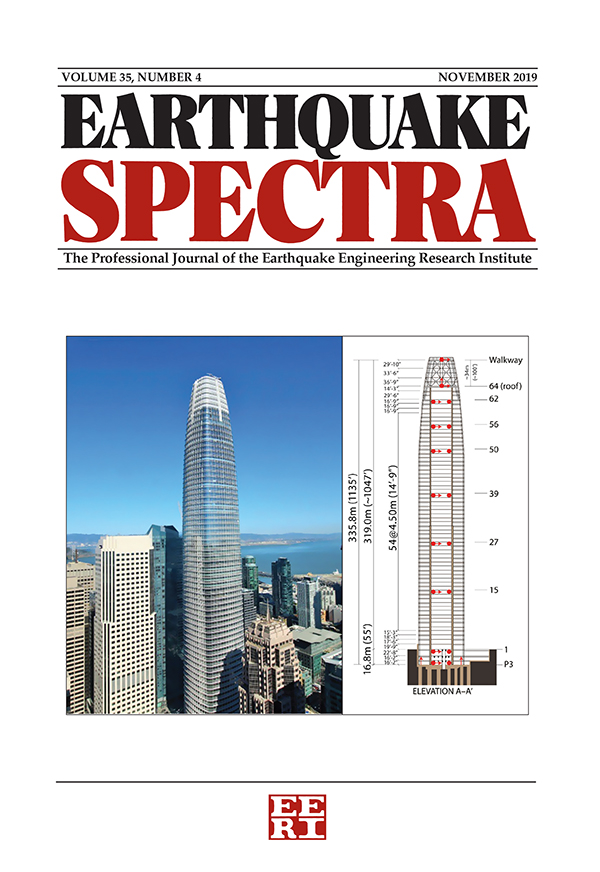考虑沉积厚度,调整美国中部和东部地动模型,以便在沿海平原使用
IF 3.7
2区 工程技术
Q2 ENGINEERING, CIVIL
引用次数: 0
摘要
本研究旨在为 Pezeshk 等人的地动模型开发调整系数,这些模型是为沿海平原以外地区开发的,可用于沿海平原地区内的地点。所开发的调整因子是沿海平原地区沉积厚度和断裂距离[公式:见正文]的函数。我们使用了 Boyd 等人新绘制的沉积厚度等值线图。此外,我们还使用了由下一代衰减(NGA)-东部原始数据集、Chapman 和 Guo 提供的数据集以及 Thompson 等人新编制和验证的数据集组成的综合数据集来编制调整因子。我们利用观测数据与 Pezeshk 等人的地动模型(GMM)预测数据的对数之差计算残差,同时考虑到 Stewart 等人的场地放大模型,并利用综合数据集。该模型适用于[公式:见正文],最远可达 1000 公里。我们采用混合效应回归法进行残差分析,将总残差分为事件间和事件内两部分。为了计算沿海平原地区各站的校正因子,我们将事件内残差与沉积厚度和[公式:见正文]的函数方程进行了拟合。结果表明,对于沿海平原地区的站点,在大多数时段,利用所提出的调整因子,残差趋势已被消除(与沉积厚度、[公式:见正文]和地表下前 30 米的时间平均剪切波速度 V S30 有关)。本研究的结果可用于沿海平原地区的地震灾害和风险分析。本文章由计算机程序翻译,如有差异,请以英文原文为准。
Adjusting Central and Eastern United States ground-motion models for use in the Coastal Plain considering the sediment thickness
This study aims to develop adjustment factors for ground-motion models such as Pezeshk et al., which were developed for regions outside the Coastal Plain to be used for sites within the Coastal Plain region. The adjustment factors developed are a function of sediment thickness and rupture distance [Formula: see text] in the Coastal Plain region. We use the newly developed sediment thickness contour maps by Boyd et al. Also, the adjustment factors are developed using a combined data set, which consists of the Next Generation Attenuation (NGA)-East original data set, the data set from Chapman and Guo, and the newly compiled and verified data set by Thompson et al. We calculate residuals by taking the difference between the logarithms of the observed data and those predicted by the Pezeshk et al. ground-motion model (GMM), considering the site amplification model of Stewart et al. and utilizing the combined data set. This model is applicable for [Formula: see text] as far as 1000 km. We perform residual analyses using a mixed-effects regression to partition the total residuals into between-event and within-event components. To develop the correction factors for stations within the Coastal Plain region, we fit the within-event residuals to an equation that is a function of sediment thickness and [Formula: see text]. The results indicate that for stations within the Coastal Plain region, for most periods, the residual trend has been eliminated (with respect to sediment thickness, [Formula: see text], and time-averaged shear wave velocity in the first 30 m under the surface, V S30 ) using the proposed adjustment factors. The results of this study can be utilized in seismic hazard and risk analyses for sites within the Coastal Plain.
求助全文
通过发布文献求助,成功后即可免费获取论文全文。
去求助
来源期刊

Earthquake Spectra
工程技术-工程:地质
CiteScore
8.40
自引率
12.00%
发文量
88
审稿时长
6-12 weeks
期刊介绍:
Earthquake Spectra, the professional peer-reviewed journal of the Earthquake Engineering Research Institute (EERI), serves as the publication of record for the development of earthquake engineering practice, earthquake codes and regulations, earthquake public policy, and earthquake investigation reports. The journal is published quarterly in both printed and online editions in February, May, August, and November, with additional special edition issues.
EERI established Earthquake Spectra with the purpose of improving the practice of earthquake hazards mitigation, preparedness, and recovery — serving the informational needs of the diverse professionals engaged in earthquake risk reduction: civil, geotechnical, mechanical, and structural engineers; geologists, seismologists, and other earth scientists; architects and city planners; public officials; social scientists; and researchers.
 求助内容:
求助内容: 应助结果提醒方式:
应助结果提醒方式:


